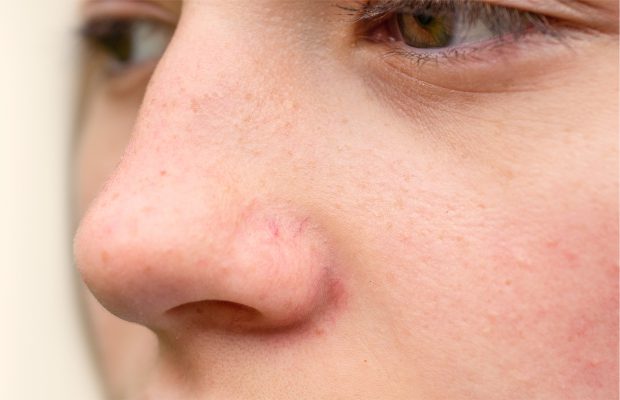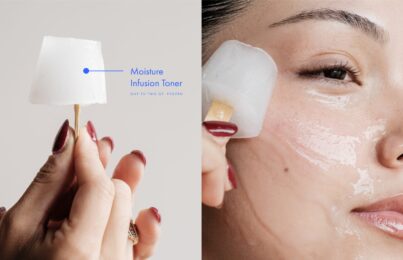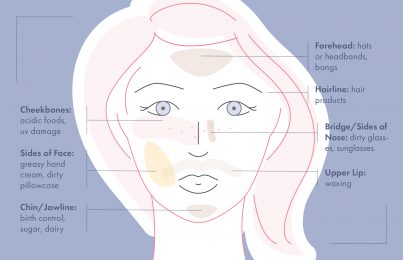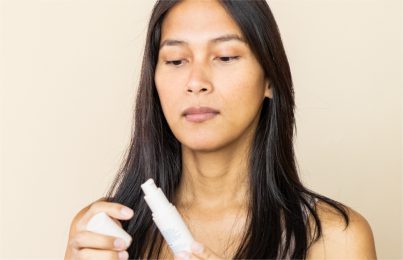Updated 07/25/22. Broken blood vessels can appear on the face, especially around the nose, on the cheeks, and on the chin. While this is actually quite common, it can certainly be frustrating to deal with. In this post, I’ll share everything you need to know about broken blood vessels on the face, including what causes them to appear, how you can make them less noticeable, and how you can prevent them from showing up in the future. Keep scrolling to learn all of this and more.
- The Cause of Broken Blood Vessels
- How to Get Rid of Broken Blood Vessels
- How to Prevent Broken Blood Vessels
- 1. Consider Taking a Vitamin C Supplement That Contains Bioflavonoids
- 2. Use a Topical Vitamin C Serum Every Day
- 3. Avoid Smoking and Excessive Alcohol Consumption
- 4. Avoid Microdermabrasion Treatments
- 5. Go Easy on (or Completely Avoid) the Use of a Sonic Cleansing Brush
- 6. Use Skincare Products With Soothing Ingredients
- 7. Avoid Blowing Your Nose Too Much
The Cause of Broken Blood Vessels
The main cause of broken blood vessels is wear and tear, which leads to a loss of elasticity. Blood vessels are like rubber bands. They can only be stretched so many times before they will no longer spring back to their original state. Eventually, they stay permanently dilated and enlarged, which brings them close to the surface of the skin. Technically, they’re not “broken” at all, they’re simply stretched beyond their capacity.
There are multiple things that can contribute to the weakening of capillary walls. Most of them are lifestyle factors. They include:
- Hot showers
- Saunas and steam rooms
- Hot yoga
- Intense exercise
- Sunburns
- Skin treatments that involve suction (like microdermabrasion)
- Spicy foods
- Alcohol consumption
- Smoking
- Rosacea
- Genetics
How to Get Rid of Broken Blood Vessels
The truth is that once these so-called broken blood vessels appear, they can’t just disappear (unless you go to the dermatologist for a permanent treatment or apply a full-coverage concealer!). I suggest choosing the first option and consulting a dermatologist. They can perform a procedure called electrocauterization, which is when the skin is heated via electricity to seal blood vessels. This is a permanent way to address them. There are also various laser treatments available. A dermatologist can help you decide which is right for you and your skin.
Even if you go the electrocauterization route, know that new broken blood vessels can appear, which is why prevention is key.
Note: Capillaries form in two colors, red and blue. The red ones are arterial capillaries, which means they contain oxygenated blood that’s coming from the heart and heading to the skin. The blue ones are venous capillaries, which means they contain deoxygenated blood that’s leaving the skin and heading back to the heart. The former are easier to address with laser and cautery procedures. The latter are deeper in the skin and are generally harder to treat. Again, this is where prevention comes into play.
How to Prevent Broken Blood Vessels
Preventing broken blood vessels from appearing is always easier than getting rid of them.
1. Consider Taking a Vitamin C Supplement That Contains Bioflavonoids
Vitamin C is essential for the skin and the body. It’s an antioxidant that can help reduce inflammation and lessen free radical activity. What is perhaps lesser-known is that the addition of bioflavonoids can help reduce bruising, help strengthen fragile blood vessels, and prevent them from easily dilating. That’s why I take 1,000 mg of vitamin C with bioflavonoids every day as a preventative measure to avoid broken blood vessels and to reap antioxidant benefits (I’m a Skin Type 6, by the way).
Read do skincare supplements really work?
2. Use a Topical Vitamin C Serum Every Day
Vitamin C supports collagen synthesis in both the skin and the capillary walls, which is why I recommend incorporating a daily vitamin C serum into your skincare routine. However, I don’t recommend incorporating just any vitamin C serum. Instead, you should choose one carefully. Since certain forms of vitamin C (such as ascorbic acid and l-ascorbic acid) are, in fact, acids, they can sting the skin and increase visible blood flow. When used daily, the redness this creates can actually weaken capillary walls.
Look for vitamin C serums that contain tetrahexyldecyl ascorbate and ascorbyl methylsilanol pectinate. These are my favorite forms of vitamin C for preventing the appearance of broken blood vessels. You can both of these forms in the Vitamin C&E Treatment, along with licorice root, which is an ingredient that provides soothing antioxidant benefits.
Read the best type of vitamin C to use and why.
3. Avoid Smoking and Excessive Alcohol Consumption
Both of these habits are not only detrimental to your health but also contribute to broken blood vessels on your face. Consider limiting these from your life, or omitting them entirely, especially if you’re concerned about the condition of your skin.
One study published in The Journal of the American Academy of Dermatology found that white wine and liquor are particularly negative. They’re culprits for rosacea flare-ups and broken blood vessel formation.
Read how alcohol really affects your skin.
4. Avoid Microdermabrasion Treatments
The original microdermabrasion machines from the late ’90s and early-2000s are still commonly used today. Unfortunately, they’re not ideal for fragile capillaries. This type of machine uses a vacuum to create suction, which allows for exfoliating crystals to lift dry cells off the surface of the skin. The suction can pull on capillaries, causing them to weaken over time. I recommend avoiding this treatment and any others that are similar to it.
Read how microdermabrasion can go wrong.
5. Go Easy on (or Completely Avoid) the Use of a Sonic Cleansing Brush
I have not been shy about sharing my personal thoughts on sonic cleansing brushes (read my review). When the bristles are massaged over the face, especially if any sort of pressure is applied, it can stimulate blood flow and cause capillaries to dilate, which can cause them to weaken over time. I recommend going easy on (or completely avoiding) the use of these devices. Opt for a gentle, sulfate-free cleanser, instead. It will clean the skin without causing problems.
Read what exfoliant should I use and how often?
6. Use Skincare Products With Soothing Ingredients
The less redness you have appearing on your skin, the better it is for the strength of your capillaries. That’s especially true if you’re particularly prone to redness and rosacea, such as Skin Types 5 and 9. Keep your skin calm by using a serum with soothing, redness-reducing ingredients. I suggest looking for one that includes various types of algae, like red marine algae, as well as green tea, allantoin, sea whip, oat kernel, bisabolol, chamomile, and azulene.
I recommend the Redness Care Firming Serum. It contains many of these ingredients for the purpose of diminishing visible redness. It also contains peptides for the purpose of firming skin. It’s a one-two punch for aging, redness-prone skin.
7. Avoid Blowing Your Nose Too Much
If you’re someone who struggles with seasonal or year-round allergies, you know all too well what it’s like to have a red nose. This presents a problem when it comes to avoiding broken blood vessels in the face. The pressure of blowing your nose, combined with the rubbing of tissue, can weaken capillaries. While it’s sometimes unavoidable, do your best to get your allergies under control and avoid blowing your nose. At the very least, keep a gentle touch when it comes to wiping your nose with a tissue.
The same goes for touching your face in general. Try to avoid picking at your skin or being too aggressive with it when applying products. When it comes to redness and broken blood vessels, the less friction the better!
There’s one more thing I want to mention. Since there is a genetic component to all of this, you can tell how likely broken blood vessels are to appear on your face by analyzing your parents’ skin. If they have a lot of broken blood vessels, you can assume you’re prone to them, too, and you can get a kick start on the aforementioned prevention techniques.
Next, learn everything you need to know about managing rosacea.
Celebrity Esthetician & Skincare Expert
As an esthetician trained in cosmetic chemistry, Renée Rouleau has spent 35 years researching skin, educating her audience, and building an award-winning line of products. Her hands-on experience as an esthetician and trusted skin care expert has created a real-world solution — products that are formulated for nine different types of skin so your face will get exactly what it needs to look and feel its best. Trusted by celebrities, editors, bloggers, and skincare obsessives around the globe, her vast real-world knowledge and constant research are why Marie Claire calls her “the most passionate skin practitioner we know.”



